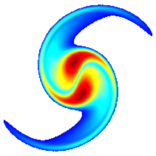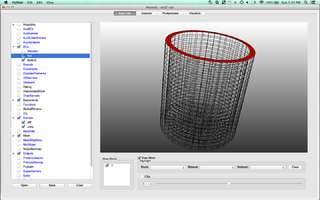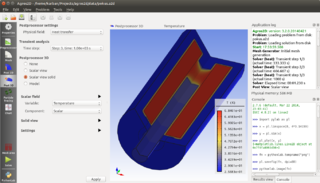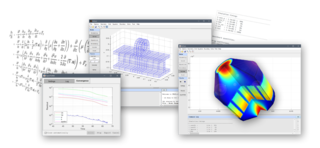
In physics and engineering, fluid dynamics is a subdiscipline of fluid mechanics that describes the flow of fluids—liquids and gases. It has several subdisciplines, including aerodynamics and hydrodynamics. Fluid dynamics has a wide range of applications, including calculating forces and moments on aircraft, determining the mass flow rate of petroleum through pipelines, predicting weather patterns, understanding nebulae in interstellar space and modelling fission weapon detonation.

In physics, the Navier–Stokes equations are certain partial differential equations which describe the motion of viscous fluid substances, named after French engineer and physicist Claude-Louis Navier and Anglo-Irish physicist and mathematician George Gabriel Stokes. They were developed over several decades of progressively building the theories, from 1822 (Navier) to 1842–1850 (Stokes).

Computational fluid dynamics (CFD) is a branch of fluid mechanics that uses numerical analysis and data structures to analyze and solve problems that involve fluid flows. Computers are used to perform the calculations required to simulate the free-stream flow of the fluid, and the interaction of the fluid with surfaces defined by boundary conditions. With high-speed supercomputers, better solutions can be achieved, and are often required to solve the largest and most complex problems. Ongoing research yields software that improves the accuracy and speed of complex simulation scenarios such as transonic or turbulent flows. Initial validation of such software is typically performed using experimental apparatus such as wind tunnels. In addition, previously performed analytical or empirical analysis of a particular problem can be used for comparison. A final validation is often performed using full-scale testing, such as flight tests.

In fluid dynamics, d'Alembert's paradox is a contradiction reached in 1752 by French mathematician Jean le Rond d'Alembert. D'Alembert proved that – for incompressible and inviscid potential flow – the drag force is zero on a body moving with constant velocity relative to the fluid. Zero drag is in direct contradiction to the observation of substantial drag on bodies moving relative to fluids, such as air and water; especially at high velocities corresponding with high Reynolds numbers. It is a particular example of the reversibility paradox.
Numerical methods for partial differential equations is the branch of numerical analysis that studies the numerical solution of partial differential equations (PDEs).
In numerical analysis, a multigrid method is an algorithm for solving differential equations using a hierarchy of discretizations. They are an example of a class of techniques called multiresolution methods, very useful in problems exhibiting multiple scales of behavior. For example, many basic relaxation methods exhibit different rates of convergence for short- and long-wavelength components, suggesting these different scales be treated differently, as in a Fourier analysis approach to multigrid. MG methods can be used as solvers as well as preconditioners.
Computational aeroacoustics is a branch of aeroacoustics that aims to analyze the generation of noise by turbulent flows through numerical methods.

Bram van Leer is Arthur B. Modine Emeritus Professor of aerospace engineering at the University of Michigan, in Ann Arbor. He specializes in Computational fluid dynamics (CFD), fluid dynamics, and numerical analysis. His most influential work lies in CFD, a field he helped modernize from 1970 onwards. An appraisal of his early work has been given by C. Hirsch (1979)
The MIT General Circulation Model (MITgcm) is a numerical computer code that solves the equations of motion governing the ocean or Earth's atmosphere using the finite volume method. It was developed at the Massachusetts Institute of Technology and was one of the first non-hydrostatic models of the ocean. It has an automatically generated adjoint that allows the model to be used for data assimilation. The MITgcm is written in the programming language Fortran.
Pressure-correction method is a class of methods used in computational fluid dynamics for numerically solving the Navier-Stokes equations normally for incompressible flows.
In applied mathematics, the name finite pointset method is a general approach for the numerical solution of problems in continuum mechanics, such as the simulation of fluid flows. In this approach the medium is represented by a finite set of points, each endowed with the relevant local properties of the medium such as density, velocity, pressure, and temperature.

Gerris is computer software in the field of computational fluid dynamics (CFD). Gerris was released as free and open-source software, subject to the requirements of the GNU General Public License (GPL), version 2 or any later.

MOOSE is an object-oriented C++ finite element framework for the development of tightly coupled multiphysics solvers from Idaho National Laboratory. MOOSE makes use of the PETSc non-linear solver package and libmesh to provide the finite element discretization.

Agros2D is an open-source code for numerical solutions of 2D coupled problems in technical disciplines. Its principal part is a user interface serving for complete preprocessing and postprocessing of the tasks. The processor is based on the library Hermes containing the most advanced numerical algorithms for monolithic and fully adaptive solution of systems of generally nonlinear and nonstationary partial differential equations (PDEs) based on hp-FEM. Both parts of the code are written in C++.
Goma is an open-source, parallel, and scalable multiphysics software package for modeling and simulation of real-life physical processes, with a basis in computational fluid dynamics for problems with evolving geometry. It solves problems in all branches of mechanics, including fluids, solids, and thermal analysis. Goma uses advanced numerical methods, focusing on the low-speed flow regime with coupled phenomena for manufacturing and performance applications. It also provides a flexible software development environment for specialty physics.
Nektar++ is a spectral/hp element framework designed to support the construction of efficient high-performance scalable solvers for a wide range of partial differential equations (PDE). The code is released as open-source under the MIT license. Although primarily driven by application-based research, it has been designed as a platform to support the development of novel numerical techniques in the area of high-order finite element methods.
The finite point method (FPM) is a meshfree method for solving partial differential equations (PDEs) on scattered distributions of points. The FPM was proposed in the mid-nineties in, and with the purpose to facilitate the solution of problems involving complex geometries, free surfaces, moving boundaries and adaptive refinement. Since then, the FPM has evolved considerably, showing satisfactory accuracy and capabilities to deal with different fluid and solid mechanics problems.

FEATool Multiphysics is a physics, finite element analysis (FEA), and PDE simulation toolbox. FEATool Multiphysics features the ability to model fully coupled heat transfer, fluid dynamics, chemical engineering, structural mechanics, fluid-structure interaction (FSI), electromagnetics, as well as user-defined and custom PDE problems in 1D, 2D (axisymmetry), or 3D, all within a graphical user interface (GUI) or optionally as script files. FEATool has been employed and used in academic research, teaching, and industrial engineering simulation contexts.
Guru Guruswamy is an American engineer working as Principal Scientist at Ames Research Center since 1988. He pioneered research in the area of computational aeroelasticity that involves Unsteady Aerodynamics, Finite Element Methods, Computational Fluid Dynamics, Parallel Computing and Problem Solving Environment. His innovative research was utilized in the first commercial 3-D computational aeroelasticity software developed by a major aerospace industry. The aeroelasticity legend Holt Ashley extensively referred to Guruswamy's research in his classical review paper. In 1988 he demonstrated the unique use of Transonic Small Perturbation based CFD for designing active controls to increase the safety of aircraft. It was followed by a break through development of Euler flow equations based Computational Aeroelasticy. It was cited by another Aeroelasticity legend John Dugundji of MIT as an important milestone in Aeroelasticity. A google search shows about 150 researchers took advantage Guruswamy's work based on the Euler equations for follow-up developments.









